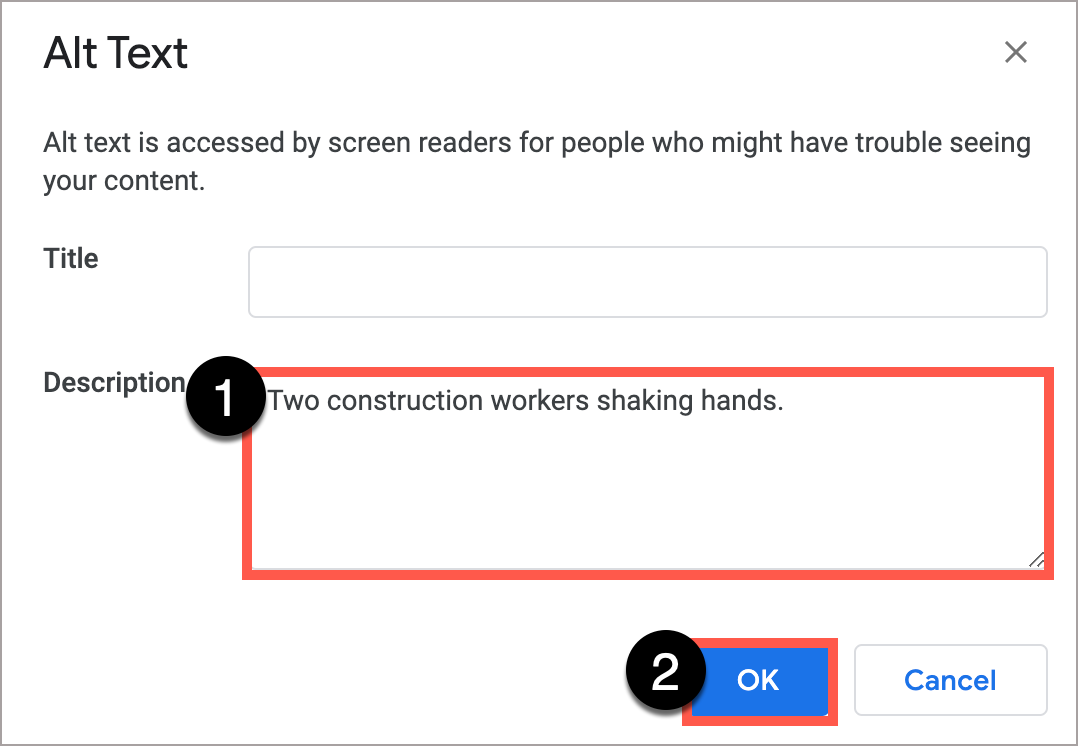Google Docs Accessibility
Google Docs includes options for adding accessibility information to documents to support access by individuals with disabilities. The best practices for Google Docs accessibility includes attention to:
- Headings & Structure
- Images
- Hyperlinks
- Tables
- Color
- Accessibility Checker
- Exporting to Other Formats
Headings & Structure
Page structure provides visual references to help readers scan and organize the content.
Headings
Headings can provide an organizational and navigational framework for a document’s content, communicating both the informational hierarchy and relationship between different sections. Headings also provide a simple mechanism for an individual using assistive technologies to “jump” from one heading to the next when navigating the document.
In the toolbar select the drop-down menu Styles button to reveal all headings.
To make an item a heading in Google Docs, select the Styles drop-down menu, located to the left of the font drop-down menu.
Headings can be marked with the following
- Mac keyboard shortcuts:
- +Option+1 applies the Heading 1 style
+Option+2 applies the Heading 2 style
+Option+3 applies the Heading 3 style
- Windows keyboard shortcuts:
- CTRL + ALT + 1 applies the Heading 1 style
- CTRL + ALT + 2 applies the Heading 2 style
- CTRL + ALT + 3 applies the Heading 3 style
Important considerations
- Headings should follow a logical structure that identifies content based on the organizational content and hierarchy of information in the document.
- Avoid skipping heading levels – modify the style of the heading if you prefer a specific font or appearance.
Lists
Lists provide a structured order to a group of connected or sequential content. A numbered or bulleted list may present the same information more effectively than simple data tables with fewer steps.
- Highlight the grouped list of items.
- In the toolbar, select the appropriate list style (i.e, numbered list or bulleted list)
Images
Images that support the content require a text description (also called “alt text”) that communicates the purpose and/or content of the image. This information is presented to the individual using assistive technologies, allowing them to hear the description of the image. Image descriptions should be short and communicate the main purpose of the image. Images that are considered decorative can be marked as such and are ignored by assistive technologies.
If a longer description of the image is necessary to fully explain its content, consider inserting a more detailed description of the image within the document text that precedes and/or follows the image.
Adding Alt Text
- Select and right-click the image.
- Select Alt Text.
- In the Description field, provide a brief and concise description and select OK.

Important considerations
For additional guidance on writing effective text descriptions (i.e., alt text), please review the information on Images.
Technical guidelines
- Refrain from placing information in the “Title” field.
- Text wrapping guidance
Formatting guidelines
- A text description should convey the purpose or content of the image in approximately 120 characters or less. Avoid repeating the same information as contained in the surrounding text.
- If the image is complex, consider providing additional information in the surrounding text of the document while providing a shortened text description.
- Do not include the file format in the alt text (Example: .JPEG, .PNG)
- Do not include “picture of” or “image of” in the alt text.
Hyperlinks
Documents containing hyperlinks to websites or other online resources can be improved by including hyperlink text that is understood by the reader. Using the full URL as the hyperlink text may not make sense to the reader, particularly if it is long.
- Place the cursor anywhere on the desired hyperlink. Right-click the hyperlink.
- Select Link
- Under Text to Display, write the descriptive text for the hyperlink, keeping the text name short and descriptive.
- Select Apply.
Color
Color can be an effective method to communicate ideas and draw attention to information. Ensuring there is sufficient contrast as well as using color in combination with other formatting can support a diverse campus community, including individuals with visual disabilities.
Contrast
When choosing colors to present text information in documents, choose color options that provide a contrast ratio of:
- 4.5:1 for regular text
- 3:1 for 18 point font and larger, or 14 point font and bold
In general, pastel colors or the “light” version of a particular color do not provide sufficient contrast against a white background.
Contrast ratios may be evaluated using tools such as:
Color and Formatting
When using color to indicate a specific condition or state, include some formatting attribute to also provide a distinguishing characteristic. For example, if a list of vocabulary words were identified only in red text, this could present difficulties for an individual who had some type of color-blindness.
Options to support accessibility can include a combination of color AND formatting, such as:
- Red text with Bold formatting
- Using an asterisk, brackets, or other annotation symbols in addition to color
For more information on using color or these tools, please review the information on Color.
Exporting to Other Formats
Google Docs to PDF
At this time Google Docs are not able to produce accessible PDF versions. If you export your Google Docs file as a PDF document, the accessibility information will not be included in the resulting PDF version.
Alternatively, your Google Docs can be downloaded and uploaded into Microsoft Word.
In the toolbar menu, select File > Download > Microsoft Word (.docx).
In Microsoft Word, run the Accessibility Checker, and address any accessibility issues before exporting to a PDF.

